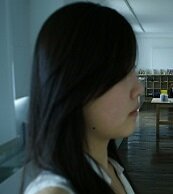Lee Ji Sun’s art life of research, ‘About the dialogue’ 대화에 관하여
Images by Lee Ji Sun

Daily sketch(Mother and the child, 18/03/2016) – JiSun LEE, image source : JiSun LEE
Dialogue of eyes
People looking down their busy walking footsteps, people handling images which slide according to their finger movement on the phone screen, people following indications which make them to get lost. There is no dialogue between people passing on the street.
The eyes, which have lost things to fix due to dizzy colors of the world look for other eyes to fix. As a mirror faces to another mirror, what I look at looks at me. Once the eyes contacted, we finally greet and smile to each other. While blinking, eyes leave to gaze the volume of the nose and to capture the rounding atmosphere.

Daily sketch(Family and friend, 20/03/2016) – JiSun LEE, image source : JiSun LEE
Dialogue of faces
Able to talk only with a few different gurgles, babies add facial expressions to their crying sounds. They smile to the mother’s smile and they are soon filled with tears of her grimace. Breaking the blank face like a thick wall, a little face expression allows to open the door to the cold castle.
And the face which has been hidden behind a heavy mask needs a while to get back. Once the natural face comes back in unconscious time flow, people facing each other, share emotions and make empathy, imitating and resembling each other like in front of the mirror.

Daily sketch(Passing time with friends or neighbors, 21/03/2016) – JiSun LEE, image source : JiSun LEE
Dialogue of images
Before any languages exist, people tried to communicate their thoughts with non-verbal hand and body gestures, or with drawings on the wall and the ground to visualize the images of their mind. After a meaningless number of years, we rediscover their tracks and imagine their mutual dialogues. In modern society overwhelmed of linguistic expressions, people replace the language and signs with images.
Without additional explanations, each speaker understands the intention of others, feels the ambience of the situation and reacts with some cute characters and simple emoticons. Artists, instead of showing themselves, search for ways of dialogue with the spectators through certain images representing themselves.

Daily sketch(How lovely this is, 21/03/2016) – JiSun LEE, image source : JiSun LEE
Dialogue of sounds
There are full of voices, engine noises, winds and musics on the street. Surfing through those unorganised noises, only one concentrated sound enters and opens the ears. The dialogue gets started when we finally hear.
As talkative people need a silent friend who would listen to them quietly, the ones who prefer listening to speaking need friends who always have various stories to tell. The one with tiny voice can reach only to those who listen carefully, despite different surrounding sounds, and the voice of a speechless person who hardly opens the mouth can be heard only by the one who greets him/her first.

Daily sketch(The warmest thing, 25/03/2016) – JiSun LEE, image source : JiSun LEE
Dialogue of hands
Even hearing the voice of people nearby, we imagine the voice of others far away. The fragile dialogue continues with fingers which busily type the instant messages. The frozen hands, no time to get warm in the gloves, keep moving here and there.
Then, by the moment when those hands lose their direction and stop, another hand holds them tight to transfer the heat connecting each other. Starting from the unfamiliar hand-shakes of the first meeting, there are hands, cheering up a depressed colleague, praying for others, calming down a crying baby, and crossing each other’s finger to promise and so on. Finally, it remains all relations as deep as wrinkles graved on the hands.
Lee Ji Sun is a young Korean artist, who does activity in Paris, France. CultureM Magazine releases her art works images by drawing, writing, video, photograph in every month. http://artleejisun.com/
이지선은 프랑스 파리를 중심으로 유럽에서 활동하는 젊은 한국여성작가이다. 회화, 비디오, 사진, 글 등의 다양한 매체로 작품활동을 하고 있는 그녀의 이야기를 컬쳐엠이 소개한다. http://artleejisun.com/











Comments are closed